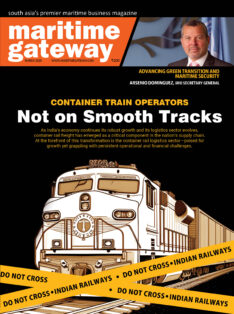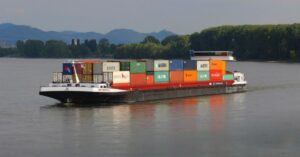“The past decade has been exceptionally well for containerised trade. We have seen volumes grow in transshipment and coastal shipping as well. During COVID this growth had tapered, but going forward with a new set of policies, capacity and infrastructure growth, we can definitely look to bounce back.”
How is the current container market situation globally and in India? Since the COVID times we have seen a lot of volatility in terms of pricing, so how is the current scenario?
The overall market sentiments are bearish, to put in a nutshell. The volumes on the demand side have been quite sluggish. Looking at port throughputs globally in terms of numbers we are not looking at more than 1% in terms of growth in 2023 over 2022. In the coming times things may change for worse with the new numbers coming in. The major markets that we are looking at declining are North America and Europe, because of the economic scenario and the subdued demand, inflationary trends, but there are some bright spots like the sub-continent particularly.
Coming to India, we have seen total port throughput increasing by around 6% in the first half, Y-o-Y. Here it is worth noting that when the entire world is growing at 1%, we are looking at more than 6% growth in the first half. But again, some headwinds are there, in the past 4-5 months we have seen the export numbers are on a decline and imports are also not increasing the way it should be, so overall trade scenario is not very positive.
This scenario is also due to the subdued demand in key markets of US and Europe, so that impact will be eminent on the growth of our exim volumes. In some of the key sectors like textiles we are facing competition from Bangladesh, Vietnam. Some of the units in Tiruppur are closing down as the production has drastically declined. Considering this scenario, the overall forecast for India during the second half of this year will be challenging.
Whatever happens in India will be the scenario for the sub-continent, because even in Sri Lanka the overall volumes are not growing much. If we continue with the current scenario we will see a 5% growth for the year in Indian trade.
Has the holiday season not given the required fillip to the demand?
It has not to the extent it was expected. Already we are coming close to the holiday season. Although shipping lines are expecting some improvement in the demand side and therefore the freight rates are showing some improvement. But probably that will not help us to grow beyond 1%, compared to last year.
Shipping lines seem to be adding capacity, especially on the Asia-Europe trade. How will it impact on the freight rates?
The tonnage supply pressure will add to the sluggishness in the demand. This is already showing as freight rates are falling in 2023 and this is expected to continue next year as well, as per our estimates. The overall average rates which we take for all the three – four key routes probably will come down by 60% in 2023 and probably by another 25-30% in 2024. The reasons are very simple, as we discussed, poor demand is much lower than what the increase in fleet size would be. In terms of total fleet we are expecting growth of around 5-6%. Then there is a combination of other factors which we term as operational capacity, which is also expected to see further increase.
We were expecting some more aggressive demolitions, especially when the freight rates were under pressure, which is a logical thing to do to get rid of some of the tonnage and try to keep the balance under manageable limits. But the demolitions have not happened to the rate as expected. Probably, the reason is that all the shipping lines are sitting on huge cash and their balance sheets are strong so they are able to sustain. Till some real pressure comes on them, they will try to stick to what they are doing now.
If you see the recent percentage of new orders, all are aimed at new technologies and new fuels, this is also putting pressure on the freight rates, because people want to comply with the new emission regulations. As per our own estimates, Asia and Europe are quite close to their breakeven numbers, so we may see more blank sailings, slow steaming and idling to balance these additional capacities to the extent possible.
There is an apprehension in the industry that there is a lot of cost involved in meeting the IMO regulations while switching to newer fuels, so is there a chance that the freight charges are increased and the burden is passed on to the consumer?
At some point it has to be done. This will definitely push up the freight rates as of now, but when the margins come under pressure, then probably the shipping lines will try to cover as much as possible and pass on the rest to the customer. But I do not expect they will try to build a profit margin on this, till the time they are in a position to dominate the negotiations with BCOs. In the current scenario the best thing would be they pass on as much as possible to the customer.
We at Drewry, have also done some calculations to compare what impact it will bring in if you compare some of the new fuels, and the white paper is out in the market. It will definitely increase the cost. Some shipping lines may opt for slow steaming to absorb the extra cost, but it is not always an easy option.
The Indian government is keen to bring in a lot of private investment into the terminals. The land lord ports are also inviting private operators to run the terminals. Are the current policy and concession agreements more congenial to the private investments?
Over the last few years the government has taken the right few steps to make it more transparent and market driven, removing some ambiguity in the agreements, especially in the major ports tariff setting mechanism. It has now come closer to the market side and this has helped the new bidders to come in. At the same time there are some new capacities being talked about. Probably when we look at their commercial feasibility, whether we are trying to cannibalise each other, so I think that problem remains to a great extent where too many projects will compete for the same cargo. But from the government’s perspective I think that is for the bidders to look for.
More of the state maritime boards are now going for +30 year concessions. In mega projects where huge capacities are to be built in, I think that gives a kind of comfort to the investor to look for a long term investment and continuity in the business. In 30 years projects, though it is a long term contract, but in the last 8-10 years the investments dry out, because the concessionaire is not sure if he will be able to get an extension for another term. So they look to do whatever best they can in the initial 20 years period, here the long-term perspective will help.
During post-COVID scenario, a lot of industry experts talked about the China+1 strategy and India could benefit out of it. But in reality our exports currently are sluggish, so what is your take on this China+1 strategy? Can India really take advantage out of it?
Businesses are trying to follow the China+1 strategy definitely and India should benefit from that. We have made some efforts in this regard, but we have been for a very short period in this scenario, we were in COVID for a short period – till 2021 and now we are in the first half of 2023. Shifting of supply chain is not easy, it takes time, so this is a very short period for us to see whether we have succeeded or failed, but probably the window is short, so we have to do things much faster than we are doing now and take advantage of this opportunity.
Companies in the electronics sector, electric vehicle manufacturers are looking to relocate into India, so the traction is definitely there. But there is a shifting cost and an inertia, which we need to tackle. The shift is happening in Vietnam and other countries, but they are too small to take everything out of China.
India is improving connectivity with neighbouring countries, but is our trade with Southeast Asian neighbours improving?
There are two things – one is the proximity which makes us the natural trade partner. Second is the improvement in infrastructure as it helps in reducing the logistics time and cost. It’s time we see how we can improve cooperation along with trade. I foresee the intra-regional trades will become the key, again I am trying to link it to de-risking of the logistics chain. If that is one of the ways to looking at it –India can become a supply base for its neighbouring countries. The major hurdle is the political scenario.
Vizhinjam Port is expected to be operational during the first half of 2024. Indian government is talking of a couple of more transhipment ports – VO Chidambaranar Port is one. India has a long cherished dream of developing a transhipment hub. What are the right strategies for developing a transhipment hub in India?
The strategy of having multiple transhipment hubs in my opinion is not helping, we may try to develop multiple facilities, but again we should be ready to cannibalise and under-utilise the assets without achieving the economies of scale, as too many ports will try to pitch for the same cargo.
Transhipment is a very price sensitive cargo and low value business, so volumes and economies of scale are key to that. If we are not able to achieve these two objectives then it will not succeed financially and commercially. Then we have Colombo in the neighbourhood. Our transhipment hubs will be competing for sub-continent volumes. These are the key points that any new port development has to keep in mind for transhipment.
Transhipment can succeed in India, because we have seen how Mundra has developed partnership with the shipping lines and they have a significant volumes in transhipment. So it is about forming liner alliance and how much volumes you can attract. Be the King Abdullah Port or the newly formed ports in the UAE – all are liner affiliated, so that is the way to go for developing a transhipment hub. If you are establishing a new business then partnership with the shipping lines need to be adopted.
Shipping lines want to use transhipment to reduce their network cost. If they are the anchor customer then they also like to have some stake. Even in Colombo we see lines supporting terminals. This is one aspect we have not explored for the terminals which we are developing.
Does the strategy really help in overall gain in volumes? If the liner bringing the anchor cargo moves away to another port, then what will be the scenario?
In totality it may not add much to the volumes because, you are moving one cargo out of another port, but still you can win some cargo from outside the region. Suppose you have a partner and it has operations at another port, so they may try to re-align some of their network and bring volumes to the new hub. To that extent, the additional volumes can come in.
Once you have a hub, you provide direct connectivity of main lines and avoid delivering into another hub. Now you are providing direct and better liner connectivity to the hinterland cargo, so that may give advantage in terms of lower freight rates and transit time. If the liner connectivity can help in developing a free zone which can be used as a distribution hub, just like the one in Jebel Ali. If the transhipment hub helps in development of hinterland as a free zone distribution hub, then it can bring in additional volumes, which otherwise would not come.
How do you summarise the ports and terminals sector in India in the last 10 years? What is your forecast for the next decade? If we are talking only about containers then the past 10 years have been really good. We have seen volume growth in coastal and transshipment as well. But the growth has tapered towards 2018, 2019 and 2020. The growth momentum has slowed down, except for the year 2022 when the recovery happened. Now we have the base, operators, capacity and not only we are developing at the port side, but also in-land infrastructure like the DFCs. We have people looking for this China+1 strategy, so we definitely have the potential to grow in the next two years. We have to play our cards well and build on this opportunity. This is an exciting time and an era where we can see another set of growth happening, due to the new infrastructure and policy initiatives taken. Shipping is a global trade and we cannot control everything, what is happening in the US and Europe is also impacting us.











